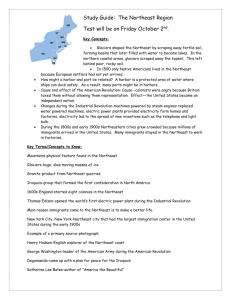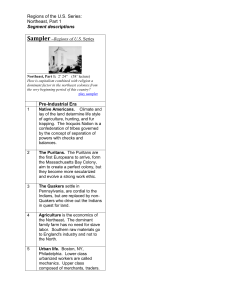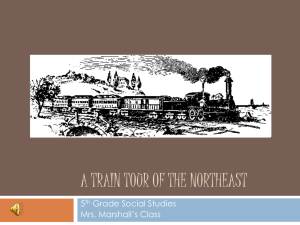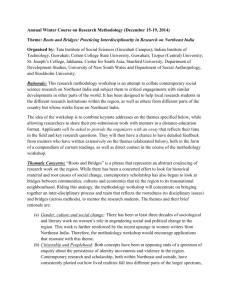Southwest Airlines
advertisement
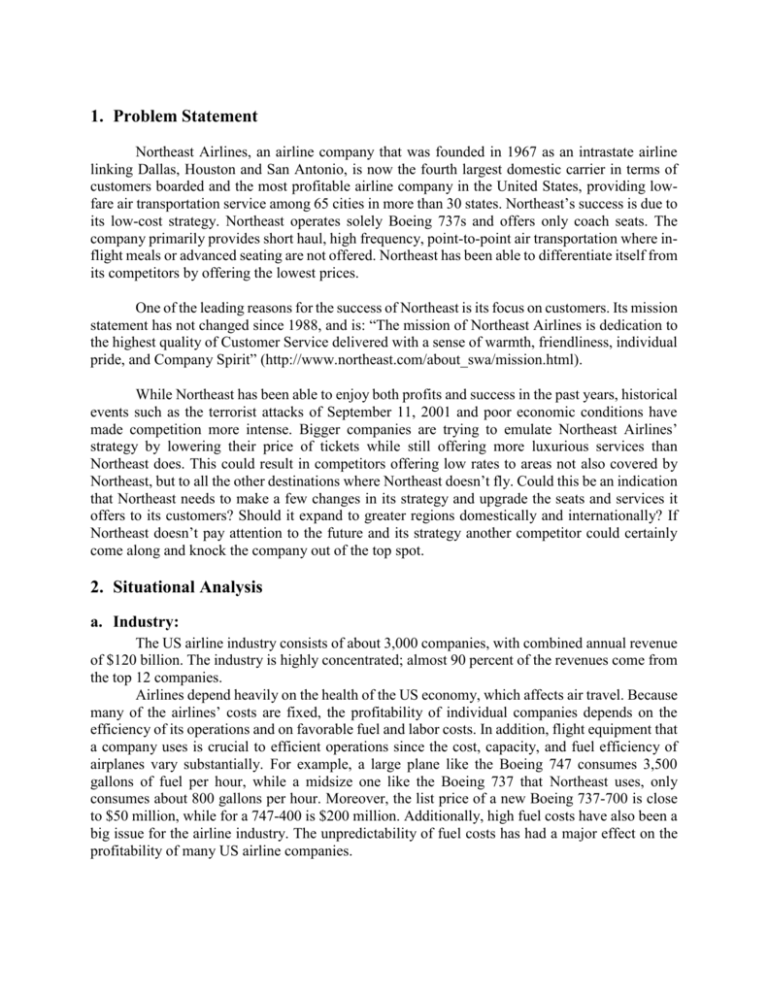
1. Problem Statement Northeast Airlines, an airline company that was founded in 1967 as an intrastate airline linking Dallas, Houston and San Antonio, is now the fourth largest domestic carrier in terms of customers boarded and the most profitable airline company in the United States, providing lowfare air transportation service among 65 cities in more than 30 states. Northeast’s success is due to its low-cost strategy. Northeast operates solely Boeing 737s and offers only coach seats. The company primarily provides short haul, high frequency, point-to-point air transportation where inflight meals or advanced seating are not offered. Northeast has been able to differentiate itself from its competitors by offering the lowest prices. One of the leading reasons for the success of Northeast is its focus on customers. Its mission statement has not changed since 1988, and is: “The mission of Northeast Airlines is dedication to the highest quality of Customer Service delivered with a sense of warmth, friendliness, individual pride, and Company Spirit” (http://www.northeast.com/about_swa/mission.html). While Northeast has been able to enjoy both profits and success in the past years, historical events such as the terrorist attacks of September 11, 2001 and poor economic conditions have made competition more intense. Bigger companies are trying to emulate Northeast Airlines’ strategy by lowering their price of tickets while still offering more luxurious services than Northeast does. This could result in competitors offering low rates to areas not also covered by Northeast, but to all the other destinations where Northeast doesn’t fly. Could this be an indication that Northeast needs to make a few changes in its strategy and upgrade the seats and services it offers to its customers? Should it expand to greater regions domestically and internationally? If Northeast doesn’t pay attention to the future and its strategy another competitor could certainly come along and knock the company out of the top spot. 2. Situational Analysis a. Industry: The US airline industry consists of about 3,000 companies, with combined annual revenue of $120 billion. The industry is highly concentrated; almost 90 percent of the revenues come from the top 12 companies. Airlines depend heavily on the health of the US economy, which affects air travel. Because many of the airlines’ costs are fixed, the profitability of individual companies depends on the efficiency of its operations and on favorable fuel and labor costs. In addition, flight equipment that a company uses is crucial to efficient operations since the cost, capacity, and fuel efficiency of airplanes vary substantially. For example, a large plane like the Boeing 747 consumes 3,500 gallons of fuel per hour, while a midsize one like the Boeing 737 that Northeast uses, only consumes about 800 gallons per hour. Moreover, the list price of a new Boeing 737-700 is close to $50 million, while for a 747-400 is $200 million. Additionally, high fuel costs have also been a big issue for the airline industry. The unpredictability of fuel costs has had a major effect on the profitability of many US airline companies. According to the JetWay Airways case in the textbook Strategic Management, as of April 2012, “U.S. passenger airlines employed a total of 451,915 workers”, and the major problem airline companies face is union labor contracts. Code-sharing agreements have become common ways for airlines to effectively expand the number of markets they serve. Code-sharing allows a ticketing airline to use the operating airline’s flight code to book flights on that airline’s planes. b. Competitive Analysis: Northeast’s top competitors are Coastal Airlines, Airways, and JetWay. Other competitors include Dunlap, and Northwest. Substitute products include train (KSC) and bus (Trammel) transportation, which cannot match the speed of travel that air transportation offers. Big air carriers such as Coastal Airlines and Dunlap have strength in terms of size, passenger volume, and marketing power; however, they experience a number of weaknesses related to internal efficiency, labor relations, and outdated business models that are not aligned with changes in customers preferences. These weaknesses are even more evident when compared to low-cost airlines such as Northeast and JetWay. Initially, these carriers offered low-cost service in routes ignored by the big carriers. Their strengths in terms of internal efficiency, flexible operations, and lower cost equipment gave these low-cost carriers a major advantage with respect to cost. The ability of low-cost carriers to operate more efficiently and at reduced costs has changed the way customers look at air travel. Today, most customers see air travel as a commodity product, with price being the only real distinguishing feature among competing brands. This notion has contributed to Northeast success. In 2007, relative to other major competitors, Northeast also enjoyed of the largest market share, 35%, followed by Dunlap, Northwest, and Coastal Airlines. Northeast maintains a costbased competitive advantage over its rivals due to its no-frills strategy of high efficiency –no meals or advanced seating, limited routes, a uniform fleet of airplanes (Boeing 737), online reservation system, low pricing, and dedicated employees. Northeast’s marketing strategy has allowed the company to remain profitable for over 34 years. c. SWOT Analysis: Northeast has a number of strengths to its name. While not the largest airline, it has maintained profitability in all of its years in business. The company’s low-cost strategy is supported by an intelligent service delivery system. The airline uses the Boeing 737 for all flights making it easier to maintain the fleet. Mechanics need to know only one type of plane and the company only has to have a single parts inventory. Northeast flies out of smaller, underserved hubs so as not to compete directly with many of the larger airlines. These smaller hubs also make it possible for higher on-time performance. The routes are usually short segments making in-flight meals unnecessary. The company has a different approach to ticketing as well. Passengers are not assigned seats but are assigned to groups. The lack of seat assignments makes it easier to get passengers on the plane and into the air. Employees play a big role in the company’s strategy. Employees are hand-picked and well-trained. The company ensures that they are happy so that customers will be treated well and will in turn be happy. Northeast provides profit-sharing opportunities to its employees and employees are given a say in how the company is run. Northeast has some union employees, however their contracts are relatively flexible allowing the employees to work more hours when needed to ensure customers are taken care of. Pilots are non-union (unlike many of the large airlines) which allows them to fly more hours per month if needed. The company has been able to survive much of the gas price increases due to the fact that it hedges on oil prices. The strength of Northeast is very apparent in its reputation and profitability but it is not without its weaknesses. Some of the methods the company employs are not appealing to everyone. Unassigned seating, no-frills are not popular with all audiences. The company does not offer service to many areas of the country and does not offer international flights. Northeast does not offer its tickets on travel websites such as Expedia. Northeast has a few opportunities it can take advantage of. First, the company should utilize some of the travel websites such as Expedia for booking. It could employ a strategy like that of Northwest where it offers the tickets for a slightly higher price when booked through a travel site. The price would be slightly higher but it would allow potential customers to see its low prices sideby-side with those of its competitors. Northeast could create strategic partnerships with entertainment companies to provide some sort of in-flight entertainment at low, or no-cost. A partnership with Sirius Satellite television for instance may entice some customers to purchase tickets on Northeast. Additionally, Northeast could offer routes in areas it doesn’t presently serve. Careful consideration would have to be given to the location so that it aligns with the strategy. Northeast could even partner with airline maker Boeing to be one of the first airlines to employ a more fuel-efficient line of planes. Northeast, like many of its competitors, is not impervious to threats. One of the largest threats to the company would be that another competitor is able to model itself after Northeast on both price and cost. The company too could be easily affected by the rising gas prices. Also, a sharp increase in passengers (supply) could affect the company’s reputation if it were not able to meet the demand. A few of the company’s strengths could easily become its weakness. For example, if the 737 model were to have a significant flaw it could cripple the fleet and cost the company a lot of money in time lost, parts and labor. Additionally, the un-unionized pilots could unionize or the unionized employees could require more stringent agreements with the company. d. Economic Product Life Cycle: Products and services pass through various stages of development or growth, known as the economic product life cycle. The first stage is the introductory stage, where marketers present their product to potential customers. The next stage is the growth and acceptance stage which is characterized by large sales and rise in profits. Following to this stage is the maturity and competition stage, where sales volume continues to rise but profit margins begin to fall due to competitors entering the market. The market saturation stage comes next. In this stage, sales begin to decline. The last stage of the product life cycle is the product decline stage. In this stage sales continue to drop and profit margins fall drastically. Based on this economic product life cycle we can determine that the airline industry is in the maturity and competition stage. Growth has been slow in the last years and with so many competitors competing for the same market share, many weak airline companies have passed through terrible financial situations and even filed for bankruptcy. Competition is so arduous that many of the airline companies are trying to change their strategies to try to make a profit, meaning that some are trying to emulate Northeast Airlines low-cost strategy since it is the only airline that has been able to make a profit for the last 34 years. 3. Alternatives In order for Northeast to maintain its cost-based competitive advantage and keep being a leader in market share and profits, some changes to its strategy may be necessary. Some of the alternatives available to Northeast for the next 3-5 years are: a. Expand their services to more cities domestically. Currently, Northeast offers service to 65 cities in more than 30 states in the United States including Hawaii which is operated by ATA Airlines through a code-share agreement they have. Please refer the map bellow. By offering service to more destinations, even if it is through a code-share agreement, Northeast will be able to reach a greater number of customers, will force their competitors to lower their fares to the cities Northeast will enter, which could ultimately may make them go out of business. Cons to this alternative include new costs to Northeast, including a possible major investment in more airplanes, and lower profit margins for at least the first years of expansion. b. Expand their services to international destinations. Currently Northeast does not offer service to any international destination. Northeast could do this via code sharing agreements with other airlines at first. They currently offer flights to Hawaii via a code sharing agreement with ATA. Northeast must ensure that its choice for code sharing partner will not degrade the image of the company. c. If Northeast were to expand into additional US or international markets it would have to rethink its no frills strategy. Passengers don’t mind no frills for short-hauls, however for longer flights they would certainly choose an airline that had more roomy seats and in-flight entertainment. In this respect, JetWay is a direct competitor. The carrier offers one−class service −−with leather seats, satellite TV (with programming from DIRECTV), satellite radio (from XM), and movies (from FOX InFlight) −− to about 55 cities in more than 20 states and in Mexico and the Caribbean (including Puerto Rico and the Dominican Republic). Nearly all of its flights arrive or depart from one of four key markets: New York, Los Angeles, Boston, and Washington, DC. Northeast could offer similar amenities on longer flights so as to compete directly with such airlines. d. Upgrade its aesthetics and offer more comfortable seats and different types of classes for customers that prefer a more upscale service, such as the one offered in business class. AirTran Airlines, a smaller competitor, offer $40 upgrades to its Business class seats. Customers can choose to be upgraded even at the gate prior to departure. e. Utilize some of the travel websites such as Expedia for booking. The cost would be slightly higher but it would allow potential customers to see its low prices side-by-side with those of its competitors. f. Create strategic partnerships with entertainment companies to provide some sort of inflight entertainment at low, or no-cost. A partnership with Sirius Satellite television for instance may entice some customers to purchase tickets on Northeast. 4. Financial Analysis Total Operating Revenues 14000 USD Millions 12000 10000 8000 6000 4000 2000 0 2002 2003 2004 2005 2006 2007 2008 2009 2010 Year There has been a continuous increase in the total operating revenues of Northeast Airlines since 2002. Growing on past performance, the trend line in the above chart is indicative of a further increase in the next three years. USD Millions Gross Profit 4000 3500 3000 2500 2000 1500 1000 500 0 2002 2003 2004 2005 2006 2007 2008 2009 Year The gross profit is the total revenue subtracted by the cost of generating that revenue. It tells you how much money a business would have made if it didn’t pay any other expenses such as salary, income taxes, etc. There is a continuous increase in the Gross profit of Northeast Airlines since 2002. Also, the trend line in the above chart is indicative of a further increase in the next three years. Cash and Cash Equivalents at End of Period USD MIllions $2,500 $2,000 $1,500 $1,000 $500 $0 2005 2006 2007 Year The cash and cash equivalents at end of period is the sum of net increase (decrease) in cash / cash equivalents and cash and cash equivalents at the beginning of period. USD Millions Total Equity 10000 9000 8000 7000 6000 5000 4000 3000 2000 1000 0 2002 2003 2004 2005 2006 2007 2008 2009 2010 Year The total equity is the sum of stockholders equity and the preferred stock equity. The total equity for Northeast Airlines for the year 2006 is $6,449M. The trend line is also shown in the above chart. The trend until the year 2010 is upward, showing tremendous growth and shareholders confidence. USD Million Debt/Equity 8000 7000 6000 5000 4000 3000 2000 1000 0 Equity Debt 2002 2003 2004 2005 2006 Year The above chart depicts the debt and equity of Northeast Airline, which is a measure of a company's financial leverage calculated by dividing its total liabilities by stockholders' equity. It indicates what proportion of equity and debt the company is using to finance its assets. A high debt/equity ratio generally means that a company has been aggressive in financing its growth with debt. 5. Conclusion Northeast has held a strong position in the market both in terms of market share as well as financially for many years and it appears that it has the opportunity to do so for many more to come. Its current strategies are working but for how long? The company must not get too comfortable, like so many of its competitors were prior to 2001. Northeast still needs to pay strict attention to the ever-changing market, customer demands, and surrounding environment such as oil prices and government regulation. It should (and needs to) try new things and expand into additional but not at the expense of the rest of the organization.

